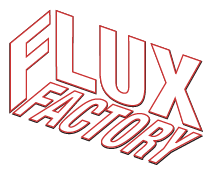Ins & Outs Magazine, Summer 2005



INS & OUTS MAGAZINE
ART WORK IN PROGRESS
By Justina Williams
Flux Factory’s warren of rooms unwinds like a Dr. Seuss landscape made manifest. Numerous small studio spaces spin off of common areas such as a library, darkroom, office, silkscreen area, well appointed shop, and a large exhibit/performance area.
Flux Factory began in 1994 in Williamsburg when a group of seven friends and former New School University graduates sought group studio space whose communal environment would provoke and incubate creativity.
In 1998, they formalized their transition from a private endeavor and became a 501(c)(3) non-profit organization. Four years later, when Williamsburg’s increasing gentrification sent rents soaring, Flux Factory Inc. moved into an old air conditioning factory off of Northern Boulevard in Long Island City. The new location’s larger space has nurtured their growth as an artists’ collective and resource, with links to materials, contacts, press, and funding assistance.
“When Flux Factory moved, it just fell into place. It all came together serendipitously and organically,” says member Jean Barberis.
GREETINGS, EARTHLING
The only hint that their LIC locale may differ from its warehouse brethren is a ceramic figure tiled to an exterior wall, an image of knee-high, blue, three-legged spaceman.
Inside, people quickly and quietly pass through the different areas and, despite the present membership of 13 Fluxers, the open spaces appear oddly organized; floors are paint-splattered but clean, a testament to an arsenal of cleaners stacked beneath a double basin sink.
The exhibit space is between shows and old pieces mill about in various states of disassembly. Around a corner, something crashes to the floor, followed by a mournful howl. A moment later comes a more reasoned assessment, “Oh well, it was balanced, well, it was balanced on nothing actually.”
At the moment, two shows are stacked weekend to weekend, with a third, “What the Book,” a display on handmade books, smack on their heels. The curator of the third show, Kerry Downey, dazedly comments, “At the moment it’s mayhem. It goes from chaos to order and back to chaos again.”
Downey adds that this is the first time she’s curated a show. Indeed, many members have made the leap from creating to curating € a result of the group’s cross-collaboration and synergy. “It’s like Wu-tang,” says Barberis.
One corner of the exhibit space is entirely covered by a floor-length velvet curtain. Kerry lifts it to reveal a ceiling-height plaster mountain sculpted to look like an ice flume. She explains the curtain’s necessity during shows:
“People tend to get distracted by it and just want to crawl inside. It can be a problem, although fun.”
GET UP IN TAR
The ice flume seems to epitomize Flux Factory’s overall goal: to cause viewers to do a double take, think, and if necessary, crawl inside.
Past projects have included ‘The Impossible Tea Party’, ‘All You Can Art,’ and ‘If Everybody Agrees that Means Nobody Understood.’
The Tea Party, deemed ‘A sophisticated experiment in Not-Drowning,’ featured inner tube-ensconced Fluxers, and their teapot, merrily bobbing amid the flotsam of the East River.
‘All You Can Art’ was composed entirely of food, from a chocolate-spackled ceiling to chocolate rugs and floorboards.
‘A lot of artists work with food, such as making jelly bean portraits, but it’s still something you look at,’ explains Barberis. ‘We wanted people to get down and eat the art, to lick the walls. One thing we all agree on is that we’re not into producing objects but into experiences.’
‘If Everybody Agrees it Means that No One Understood,’ Fluxers’ exhibit at the Queens Museum of Art, consisted of three months of assembling and disassembling a giant erector set. Sporting bright orange jump suits, they started each day with tea and a ribbon cutting ceremony, in addition to stirring up the occasional madness and mayhem.
Tom Finkelpearl, Queens Museum of Art Director, recalls their time together with mixed emotions.
“At one point they dug into the museum, in between the walls, and were sort of peeking out at visitors. Then they painted a sign on the roof and added a model of the Flux Factory Pavilion to the Panorama . . . Kind of funny, kind of annoying,’ he says.
However, he adds, ‘We remember our roots. We think Flux Factory is great and would write them a recommendation, but a lot of museums aren’t ready for them.’
‘We want to break down the formal concept of galleries and have more fun, make it less snooty and show interesting work,’ explains Kerry. ‘Things on a wall are distant and people miss being able to touch and smell. People are craving more intimacy with art.’
THEY COME IN PEACE
Though Fluxers may occasionally traumatize, they are primarily focused on helping.
A website missive explains, ‘Artistic vision can only reach its fruition when it is linked to the grander struggle to improve and enrich the community at large.’
“Our ultimate goal is a real exchange with the community where they give us input into what they enjoy seeing.
‘The more people that know about us, the more people can take advantage of us,’ said Barberis.
The Flux Factory also provides a series of free weekly classes to the public through their Tech Initiative. Topics range from Linux, electronics, sewing, filmmaking and photography to puppet making, sewing and, for those who find recycling too passee € knitting with plastic.
